Final report for FNC18-1135
Project Information
Hearthstone Berry Farm is 50 acres in northern Ashland County, Ohio. Twenty-eight acres is leased for agronomic crop production and 6 acres is developed into a pick your own berry farm and farm market. In operation since 2008, we primarily grow niche crops such as black currants, elderberries and Asian pears. We have educational outreach opportunities each year with a regular open house as well as pruning classes and blacksmith demonstrations. One-on-one instruction is also given to anyone that has an interest in the crops we grow. We operate the berry business with integrated pest management ideals and work to reduce both pesticide and fertilizer inputs through sustainable management practices. This is a part-time business with plans to increase the scope of the outreach when we, the owners, retire.
Figs (Ficus carica) are a subtropical shrub grown by gardeners in many parts of the country. Figs fruit on the current year’s wood of a mature shrub with some fruit produced on two-year-old wood. Yearly dieback of growth will significantly delay or even eliminate the crop. Home production of figs outside of their temperate zone involves cultivar selection, placement in an appropriate microclimate and/or winter insulation. Commercial production requires reliable and affordable methods of providing the same protection.
Some operations have begun to grow figs in high tunnels to produce a niche crop for their market. Production of figs with winter protection needs to be quantified for return on investment under various overwintering conditions. A comparison of methods with a control group will be needed. Figs will be grown in high tunnels, under low tunnels and with no protection. Four varieties of hardy figs will be used. The crop will be irrigated. Data collected will include: harvest dates and quantities; annual growth (caliper and length); insect and disease problems; and sales. Successful establishment of a fig planting for research could lead to new information regarding fig production such as pruning and pest problems in this region.
- Establish a trial planting of figs using three types of overwintering methods: high tunnels, low tunnels, no protection (control).
- Trial four hardy fig varieties.
- Make a comparison with existing fig planting in USDA Zone 6.
- Quantify the shrub’s annual growth and harvest for each method.
- Make seasonal observations to look for growth characteristics or problems that may be unique to high-tunnel production in Ohio.
- Prepare sample budgets for each production method.
- Provide outreach and education to other growers in the region.
- Extension Programs
- Trade Association Meetings
- On-Farm Field days
- Curriculum for programs
Research
"Hardy" figs can be grown to some extent, with protection, in northern Ohio. Figs will be grown in a farm setting under three conditions: normal field planting with deep mulch, low tunnel protection with deep mulch over winter and high tunnel protection over winter. Four hardy figs will be grown in these experimental blocks to see if they are hardy enough to grow as a niche crop in our area.
Figs were planted on 6' centers with 10' between rows. The field and high tunnel planting were mulched 18" deep for some protection with low tunnels providing the additional experimental condition. The high tunnel being used is 12' at its peak. Local growers that have tried figs found that a typical 8' hoop house will not fit a full grown fruiting fig. The 12' house will provide the additional height but it will also change the temperature dynamic from the 8' houses.
Figs fruit early on overwintered wood and late on new wood. If figs overwinter in the field they will only produce a late crop which will not entirely mature prior to frost. If figs overwinter more successfully in low tunnels they may start, and fruit earlier with a potentially larger harvestable crop. If figs overwinter in the high tunnel they may produce an early crop from any overwintering wood, and start earlier, fruit earlier and be able to mature more of the fruit in the protection of the high tunnel.
Expenses and any harvest will be tracked to see if this is a practical niche crop for production in unheated structures in northern Ohio.
First practical data will be collected in 2019. Some of the test plants may need to be replanted.
Educational & Outreach Activities
Participation Summary:
There were no formal educational programs the first year. Plants were only installed that season. The first practical data set was collected in 2019.
Consultation
Consultations were informal one-time inquiries into either the SARE project or fig growing. They were either eMail, text message or personal contact.
Curricula
Curricula encompass all outreach activities. A fig module was created for incorporation into larger fruit-growing Powerpoints. They were used in Master Gardener trainings and grower education. A complete fig presentation was under construction for classes this spring; they were, however, cancelled and the work will be completed with current data this summer.
A two-page fact sheet was created for the field day. It incorporated the research plan, results and grower information from University of Maryland. [Attached]. Fig Field Day handout 092119
Press
A newspaper article was written to advertise the fig project and information on fig growing. Distribution 24,000 [original text attached]. Chronicle 091519 fig winter
Farm Bureau contacted us about an article on the project in 2018, but they agreed to wait until 2019 when the figs had a year of growth. A three page article about the farm, project profile and SARE credit was published late fall, 2019. Distribution 100,000 households [attached]. Farm Bureau Figs p26-28
Talks
A fig module was added to a full fruit-growing conference/class presentation. Information on figs as a possible niche crop was, therefore, included in the general fruit presentations.
A single-topic fig presentation is mostly completed for the 2020 season. However, the two presentations planned for spring 2020, were both cancelled due to COVID19. Organizers of these Extension classes have committed to rescheduling in 2021; anticipated combined participation was around 110.
Field Days & Tours
I have considered field days and tours together as I have connected with more interested growers and hobbyists through small or individual tours than through the field day. Our farm is remote, the crop is unique and any individual day might not be the best choice. Our first field day attracted 6 interested growers. But, throughout the season I had provided tours to small groups and individual growers or hobbyists. Field day advertising was sent through Extension office eMail lists and incorporated into a newspaper article and Facebook advertising [attached] Fig Field Day.
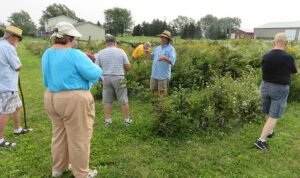
2020 Educational Outreach
Since 2020 saw the shutdown of most activities this year, the educational outreach is summarized here as a means of listing the exceptions to the planned work.
Every class, conference, and event I was scheduled to speak at in 2020 was cancelled; only one was moved to a virtual event and is scheduled for January. Our farm was closed to the public and we only had people picking by appointment so we had no casual tours this year. Our farm open house and associated tour was also cancelled. Our plan to have private fig tours in late Fall was cancelled when our county Covid numbers put us in the high-incidence category. We tested a virtual meeting in early November from the farm but without internet, we had to rely on a cell phone hot spot which lacked the band width for streaming video and kept dropping the call.
Our workarounds for the above problems were to consult via eMail and messages with interested persons. We had a surprising number of eMail and calls from people that read the articles published in 2019 about our SARE project. Fig consults were provided to contiguous states and as far as Wisconsin. Those numbers were added to the total number of eMails and consults above. Also, professional growers and educational colleagues were able to meet remotely for virtual fig-meetings.
In lieu of the failed virtual fig meeting, I had stitched together our virtual videos, photos, and some audio from what was to be the virtual field day. This is available on request in its entirety via our Facebook page or eMail. The full version is broken down into roughly seven minute segments for online publication as available and on Facebook.
Going forward, many of the organizations are hopeful they will be able to reschedule my canceled presentations for next year, but as we know that is also questionable until summer or fall. Also, the fig teaching module started in 2019 is now complete with the data from the conclusion of this project. As our society opens up and people begin to interact again, the educational outreach from this project will continue, just one year later than planned.
I am not totally pleased with the workarounds made as I am a public speaker and am best with in person instruction. But, they will work until our near-normal life returns.
Learning Outcomes
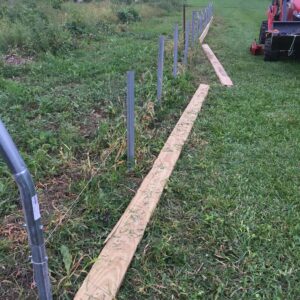
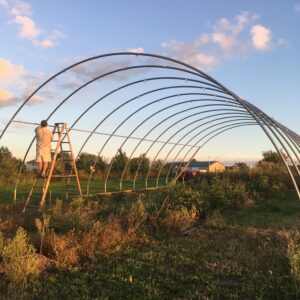
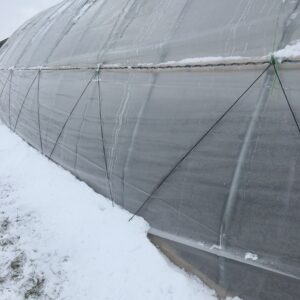
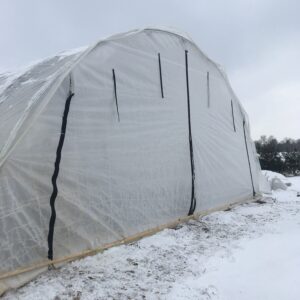
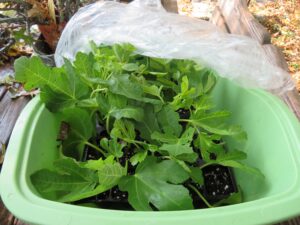
Initial year, 2018
Plants were ordered after receipt of the grant and received in May and June. Smaller plants needed more time in pots before planting. Therefore, several different sizes of plants were installed over the season making comparisons difficult. Ideally and going forward, the figs should be propagated the year prior to the study/installation year and installed uniformly in late spring of the initial study year. We held back several plants in containers as propagation stock for year two replacements.
As figs are a new crop to our area, we were wondering if they would be attractive to native vertebrates. Deer did not touch the plants in 2018, but rabbits moved into the high tunnel and girdled may plants. Figs resprout from low in the crown, so this damage is not fatal to the plant but would inhibit earlier fruiting in subsequent years. We will have to add rabbit control to the 2019 fall preparations.
Farm operation was impacted more significantly than anticipated from unanticipated labor problems and high tunnel maintenance. Those needs pulled owners away from other farm operations.
The high tunnel was constructed with additional bracing and anchors, but mid and late winter storms with winds officially clocked at 67 mph (local roofers claim they hit 70 mph) tore off the SE endwall of the high tunnel--several local residences also lost roofs and there were significant numbers of downed trees. I don't know if I could have anticipated that degree of weather, but this grant could have never funded a more hardened structure.
Year 2, 2019
None of the treatment blocks have begin to sprout as of late April 2019, which is normal for overwintering figs. However, though the high tunnel figs should have had higher winter soil temperatures (which is indicated by the prolonged turf and weed growth in fall as well as the early greening of same in spring) they are sprouting no earlier than the control of low tunnel blocks. Addendum: Just after submitting the above report, figs within the high tunnel did begin to sprout, early May.
I do plan on asking for an extension of the grant to continue fostering the plants. Woody plant material will return better experimental data in subsequent years. And, we are fully committed to this project so subsequent expenses will be budgeted by the farm. The field days will depend upon any extensions.
2019 Growing Season
Winter Survival
Though they were killed to the ground, the high tunnel figs emerged up to one month earlier than the low tunnel figs. They grew to a typical height of 4’, much shorter than expected. All three test cultivars [brown turkey was not planted in 2018] bore fruit, though in small numbers and not all plants of each trial variety bore fruit. First fruits were harvested in September and last fruits in November at which point temperatures dropped and no additional figs matured.
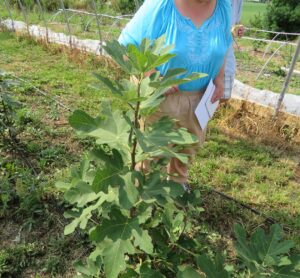
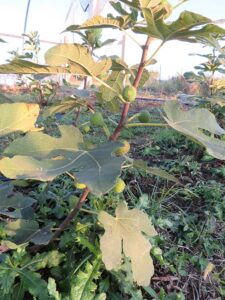
All of the low tunnel figs emerged late spring and grew to a typical height of 3’ by fall. They produced immature fruit which did not ripen. This would be typical of unmanaged figs in northern Ohio.
Only one fig, a single 'Chicago', survived in the control block. All other trial figs and guard plants did not emerge in 2019. As this was the expected outcome for the control block it was not replanted in 2019.
As of this report, figs have not yet emerged in the high tunnel and this would be consistent with last year's data.
Harvest
The only harvestable fruit from the project in 2019 was from the high tunnel figs. Only 74 mature figs were harvested from the three test cultivars. 'Chicago' provided the most fruit, followed by 'Olympian' and a few fruit from 'Marseilles'. Interestingly, 'Marseilles' was the first fig to break dormancy and was the tallest and most robust, tropical plant in the high tunnel. But, it set fruit later and most never matured. Fig Report tables
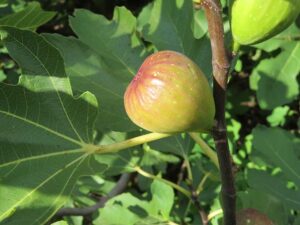
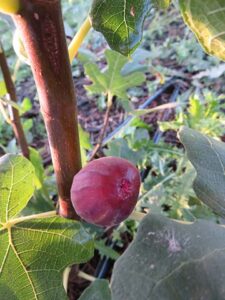

Low tunnel, field grown figs became inactive, though not dormant, early in October. High tunnel figs remained active into the second week of November, giving them almost five extra weeks of a growing season. However, though the high tunnel provided needed temperatures, sunlight just was not there to rapidly ripen the fruit so rate of ripening dropped off in October within the high tunnel.
Unforeseen Problems
A late winter storm tore off the south endwall and Southeast side of the high tunnel and rolled up both of the low tunnels, tearing their anchors from the ground. Official reporting clocked the winds around 68 miles per hour but locals claim winds in excess of 70 mph. There were many downed trees and roofs damaged or lost during the storm. The damage occurred after the low winter temperatures and should not have affected winter survival.
Low tunnels were put back in place, but the high tunnel needed to be re-covered in the fall and the endwalls replaced by a solid endwall built to pole-barn specifications. This will create a shading issue for 2020.
Discussion
At this point in the project we could report:
>Figs can be overwintered with as little as a low tunnel and still emerge from the crown.
>High tunnels only [unheated] , may not provide the return needed to make a profit from a fig crop in Northern Ohio.
>We are hoping a 3 year old root system will provide the needed support for a better crop of figs in 2020.
Items to Consider from the Project
>Tunnel height plays an important part in heat management. The height was selected due to a cooperator’s figs exceeding the height of his 8’ high tunnel. But, this project’s 12’ high tunnel may not provide the environment for consistent winter protection.
>For those considering grants, don’t go cheap on the grant. Solid endwalls were needed on the high tunnel for this project, but the added initial expense would have made the project untenable. However, a storm of that magnitude was not expected and the structure held up to slightly less winds throughout the season. Make your best judgement call and be prepared to deal with unforeseen circumstances. This will adversely affect time allotted to the project and your daily farm work as well as additional personal expense or abandonment of parts of the project.
>Our planned field day in 2020 will be in late August to early September to coincide with the maturity of the fig planting. COVID19 will make it an interesting year for program planning but we will get a date on the calendar as soon as Ohio provides an indicator on their long term plans for their anticipated second COVID19 peak in the fall.
>Pest pressure was something we were not going to evaluate, but will discuss in our final report.
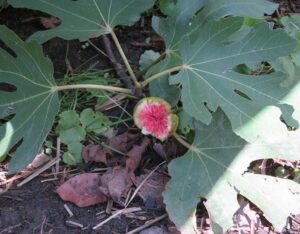
2020 Season
Fate of Experimental Plants
Control
The control block was not replaced and all figs had died as anticipated. The exception was a single 'Chicago Hardy' which also survived in the 2019/20 winter without any protection. It again re emerged in early June and did not produce any harvestable fruit due to its late start. It reached three feet in height and produced several unripe fruit up to 2 cm on 4 canes. Cuttings will be taken of this survivor and provided to our cooperator. Resulting transplants will be planted out in the control block to see if the survival of the original is related to its position.
Low Tunnel
Consistent with the 2019 season, every low tunnel plant survived the winter but emerged too late to provide much of a harvestable crop; emergence was late May through early June. Overall height of the plants was consistent with 2019, 3 to 4’ per plant. Overall cane development was also limited to between 4 and 6 small-caliper canes per plant. Though they did not produce at all in 2019, the more mature plants provided some harvest in 2020. 'Chicago Hardy' was the most productive with its smaller fruit. Very few of the larger 'Olympian' ripened before frost. Many small, green unharvestable fruit remained on the plants at the time of the first killing frost.
|
Three plants each variety |
Total Fruits for the Season Low Tunnel |
|
Chicago Hardy |
25 |
|
Olympian |
8 |
|
Marseilles |
0 |
|
Brown Turkey (new plants) |
0 |
High Tunnel
Consistent with 2019, the high tunnel plants emerged beginning late April into the second week of May. 'Marseilles' was the first variety to begin growth. Both 'Marseilles' and 'Chicago Hardy' kept overwintering wood. The one year old 'Brown Turkey' died to the ground. All three varieties produced new canes from the base.
The more mature 'Chicago Hardy' and 'Olympian' produced more canes per plant and matured more overwintering wood. Both varieties overwintered 1 to 2 canes, though they were dead to about half their original height. Overwintering wood produced new growth with ripe figs earlier than the newly emerging canes by about two weeks. We decided to thin the figs to 8 healthy canes per crown to limit the fruiting wood and allow for typical air circulation and sunlight benefits of pruning.
'Chicago Hardy' plants reached eight feet in height by the end of the growing season; 'Marseilles' and 'Olympian' grew to 10 feet tall. Fruit was harvested from no higher than 6 feet on any plant in the high tunnel.
Harvest began in late August on 'Chicago Hardy' followed by 'Olympian' by early September. Harvest continued in 2020 though November 17 providing a harvest window of around 12 weeks in the high tunnel. Harvest began with a few fruit per plant but accelerated to ten or more fruit per plant every three days on average. With some experience, we began to harvest every three days. A final harvest was done just after the plants were chilled in the high tunnel and all of the fruit began to flag; the quality was not as high in this final harvest but the fruit was of acceptable quality.
'Marseilles' did not ripen any fruit after the initial ripening of fruit on the overwintering wood early in the season.
|
Three plants each variety |
Total Fruits for the Season High Tunnel |
Fruit per Plant |
Average New Canes per Plant |
|
Chicago Hardy |
106 |
35.3 |
11 |
|
Olympian |
124 |
41.3 |
14 |
|
Marseilles |
6 |
2.0 |
17 |
|
Brown Turkey (new plants) |
4 |
1.3 |
4 |
Discussion
Fate of the experimental plants.
The single 'Chicago Hardy' survivor in the control block will be maintained. Propagation stock from the plant will be provided to the the project cooperator and a few more test plants planted outside with no protection.
The plants in the low tunnel group will be removed. Since they were not commercially productive the space will be reverted to vegetable crops. 'Olympian' and 'Chicago Hardy' plants will be moved to the high tunnel.
The high tunnel will remain in fig production for the foreseeable future. Though not quite profitable for our market, the plants were more productive with each year of maturity. Continuing to monitor the high tunnel production for several more years will reveal the extent of the maturity of the plant, root system, and pruning practices on the total marketable harvest. Increased production will open new markets and a possible increase in price.
Harvest
After we gained experience in gauging ripeness we were able to harvest every third day. A couple warm weeks during fall increased picking to every other day during those weeks. Figs were picked when they were in color—full purple for Chicago Hardy and yellow with purple cast for Olympian—and soft but not squishy (an overripe tomato might be the best comparison). Olympian is a much larger and less sweet fruit than Chicago hardy. The former weighed in at 33g per fruit average and the latter 20g per fruit average.
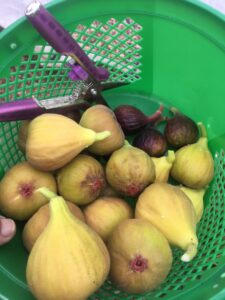
Our observations on harvest are consistent with that of a cooperator, Mulberry Creek Herb Farm (MC). They have a few bearing figs and were harvesting at the same frequency, but with lower numbers and for a shorter period, than our plants. MC heads back their plants to promote ripening and to limit height due to their smaller 8’ high tunnel. The MC plants were also not thinned. MC reports that their two varieties, Chicago Hardy and Black Mission, are indistinguishable in harvest, fruit type, or growth habit.
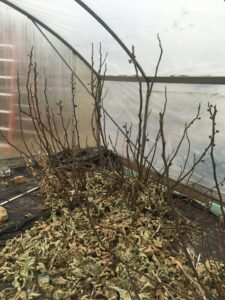
Heat, Water and Weeds
The high tunnel is not shaded. This was not a problem for us or for MC. Both our our structures have roll up sides. Additionally, our endwalls have a large open door which remains uncovered for the growing season. Due to the distance to the farm, we do not change our ventilation daily. Instead, we regulate the temperature by adjusting the sidewalls and doors in response to the weather forecast. The high tunnel runs fully open during the summer. We begin to drop the sides when night temperatures drop below 50F and are fully closed when night temperatures are consistently in the 30s. We let the day temperatures run very high with high humidity through fall. The goal is to build up heat in the soil as much as possible.
Irrigation is provided by drip tape and oscillating sprinkler. The goal for irrigation was 1.25 to 1.5” per week. We do not chemigate and the high tunnel remains covered throughout the season so the sprinkler was used to disperse and incorporate surface-applied nutrients. Heavy irrigation was continued until the irrigation system is shut down prior to freezing. As with the temperatures, the goal was to increase thermal mass potential in the soil and to keep roots hydrated well after the irrigation was turned off.
Primary weed control was with a 4” mulch of wood chips. Weeds were hand pulled. Aisles were grass, legume and weeds. In 2020 the robust growth indicated that we will need to move to an all-mulch floor in the high tunnel—the small amount of turf left near the mature plants is not worth the effort of mowing.
Variety Selection
Though the variety population in this trial is small, it is apparent that some figs performed significantly better than others. First however, it needs to be mentioned that ‘Brown Turkey’ was planted a year late due to a crop failure from the supplier. It is one year behind the other varieties and would be expected to have a comparable performance in 2021. Therefore, it is not included in the discussion of overall performance.
‘Chicago Hardy’ and ‘Olympian’, by far, outperformed ‘Marseilles’ in all comparisons. Though ‘Marseilles’ overwintered and a few canes grew to almost 8’, it never produced more than a handful of fruit. Green, unripe fruit on ‘Marseilles’ was present on the plant into November but they never ripened. ‘Marseilles’ was also prone to dropping immature fruit. This may indicate that there is some other condition limiting its performance, but that is beyond the scope of this study.
Production of new canes appears to be important in management of the figs. If we continue to thin figs to 8 canes, sufficient replacements will be needed. Management of canes in production of blueberry, elderberry, currant is very important, and as long as figs are in production their cane count and replacement also needs to be considered. Since the figs tend to die back to the ground typical training to a bush or tree form is not applicable. At this point, the eight cane format looks promising. If more mature plants can overwinter a larger caliper branch above the ground different training methods might be considered. Our cooperator at MC does not selectively prune. They have been able to overwinter some larger caliper trunks but nothing that consistently makes it through winter.
Market
Both MC and our farm found a price of 50 cents per fig is about what our market would accept. Both of our operations are in rural areas. This is likely one of the more important factors in figs being a viable commercial crop. A larger, longer harvest could let us supply a market with a higher price point. Every buyer of our figs this year returned one or two more times and were extremely happy to find local fresh figs.
Commercial Viability
Figs as a Niche Crop in Northern Ohio was proposed to collect data on fig production in a climate where protection from freezing is absolutely required, and to extrapolate proven production to a high tunnel system. The goal was to move beyond anecdotal information and provide firm numbers. Individual results will vary from location to location and with individual growers, but this provides a baseline to consider and should inspire other growers to changes in planned production.
There was variability within the three variety replicates so that the average yield per plant was significantly lower than the highest yielding plant of any one variety. This could be due to the location within the high tunnel (history of the bed that the high tunnel was on). Half of the total harvest for a variety was from one of the plants.
|
High Tunnel 3 plants each variety |
Total Fruits for Season |
Avg Fruit per Plant |
$ Yield/plant at $0.50 |
Total for 16 plants |
|
Chicago Hardy |
106 |
35.3 |
$18 |
$283 |
|
Olympian |
124 |
41.3 |
$21 |
$331 |
Our market price for figs was 50 cents each so the total income from a variety, extrapolated to a full high tunnel, was around $300. A generous, and admittedly not firmly grounded in statistics, look at the potential yield for the high tunnel can be made by taking the best individual plant yield and using that to estimate the whole high tunnel. With this best-case scenario the yield would increase to around $500 per year from the high tunnel.
|
Highest yielding plant |
Total Fruits for Season "best" plant |
$ Yield/plant $0.50 |
Total for 16 plants |
|
Chicago Hardy |
58 |
$29 |
$464 |
|
Olympian |
64 |
$32 |
$512 |
The main fixed startup costs for this project were $5609 (greenhouse $4913 + construction labor $520 + starter plants $176).
Annual labor for mulching, weeding irrigation, etc ran around $546.
From these numbers, growing figs in this project was not and is not a commercially viable crop. The payoff for the high tunnel itself is ten years. A conservative average of 6 hours of maintenance per month is more than the income from the figs.
|
Tunnel Kit |
$4913 |
|
Starter Plants |
$176 |
|
Construction Labor |
$520 |
|
Seasonal Labor (avg) |
1.5 hr per week avg x 28 weeks = $546 ($13/hr) |
|
Mulch |
Inc in farm operations |
|
Irrigation |
Inc in farm operations |
|
Fertilizer |
Inc in farm operations |
Given these numbers one can plan and estimate cost savings for fig production going forward. First, we purchased a high tunnel kit to make the ordering and grant proposal easier. A significantly less expensive high tunnel can be purchased with more time spent shopping around for the parts needed, or by purchasing a used high tunnel. Also, a smaller high tunnel could be used if one takes into account the height above the row or prunes accordingly. An existing high tunnel can be moved over to fig production.
Second, less expensive starter plants can be used. Our plants were larger for a faster start. Younger plants or even cuttings can be used for cost savings.
Third, attention to production to maximize harvest (good for any part of an operation) will increase the yield and income. But, using our best-case scenario (above) I don’t think there is too much room for improvement here.
Fourth, increasing the market price for the figs is probably the easiest means of approaching profitability, especially if combined with the other proposed cost-savings. Even raising the price to $0.75 next year would then cover the labor; we might be able to reach $1.00 in our local market.
Finally, I don’t think we can fairly decrease the labor estimate. Six hours per month is quite low and if one considers all of the operations of greenhouse maintenance, irrigation, mulching, and more, six hours is probably low. Our mulch is free. Irrigation and fertilizer are very difficult to separate from regular farm operations and so were not included here, but would likely amount to less than $100 annually if they were segregated. High tunnel plastic will need to be replaced in five or six years, adding to maintenance expense. This study was in Ashland county Ohio, where winter low temperatures can drop to 15F for several days. Any variation, warmer or colder, from these conditions would increase or decrease the potential harvest.
In summary, growing figs as a niche high tunnel crop in Northern Ohio is not commercially viable unless you can better control the expenses and incomes presented in this project. Anecdotally, the project looks great; growers, hobbyists, and the general public like the looks; and it is a unique and fun crop to grow. The fresh fruits are great and buyers return for more multiple times. However, unless you change the numbers as outlined above, it is still an anecdotal success but not a financial one.
Project Outcomes
Three Extension Educators have either attended the field days or toured the project individually. Though they are not involved with fig growers they report that knowledge of the project will be useful in working with interested clients.
The article in the Farm Bureau magazine has led to many contacts via eMail, Facebook, phone and by farm visit. We have been getting almost monthly inquiries during the season regarding figs for hobbyist or persons considering small scale production. Contacts are from out of state as well as local and I even had two this week while working on the final report.
The project cooperator from Mulberry Creek is planning on modifying his small fig planting after seeing the results from this project. Though he was initially providing feedback for the project he was very receptive of what our project had demonstrated.
Projects with woody plant material take an initial year to establish the plant material. Much of the data would be expected in year 2 and with extensions years 3 and 4 of a study.
Personally, I have found that the benefit of the project extends well beyond the life of the formal project. I have been using data and experience from an earlier project [FNC09-772] for the last decade to write, teach, and report. I still get inquiries for assistance as a result of that 2009 project. For instance, just yesterday I helped a grower with the marketing of his crop--thousands of dollars of potential impact--directly related to the original project. Update: I just received (Nov 2020) an inquiry from a grower in Oregon regarding my opinions and experience with elderberry varieties.
The number of exceptions I have had to make for Covid are significant and I am glad SARE is flexible in their outreach requirements this year. Personally, I am not fond of virtual events and am anxious to make my presentations in person even though it will be well after this project is complete.